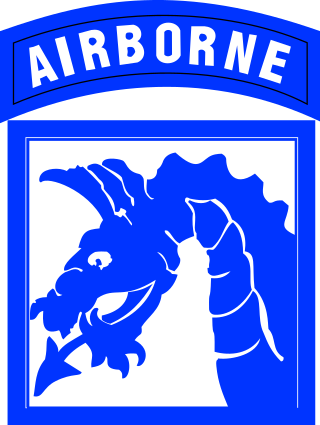
The XVIII Airborne Corps is a corps of the United States Army that has been in existence since 1942 and saw extensive service during World War II. The corps is designed for rapid deployment anywhere in the world and is referred to as "America's Contingency Corps." Its headquarters are at Fort Liberty, North Carolina.

Fort Moore is a United States Army post near Columbus, Georgia. Located on Georgia's border with Alabama, Fort Moore supports more than 120,000 active-duty military, family members, reserve component soldiers, retirees and civilian employees on a daily basis. As a power projection platform, the post can deploy combat-ready forces by air, rail, and highway for their designated mission. Fort Moore is the home of the United States Army Maneuver Center of Excellence, the United States Army Armor School, United States Army Infantry School, the Western Hemisphere Institute for Security Cooperation, elements of the 75th Ranger Regiment, the 1st Security Force Assistance Brigade, and other tenant units.

Harold Keith "Johnny" Johnson was a United States Army general who served as Chief of Staff of the United States Army from 1964 to 1968. Regarded as a premier tactician, Johnson became skeptical that the level of resources given to the Vietnam War, much of which went into 'find, fix, and destroy the big main force units' operations, could deliver victory. Johnson came to believe that the Communist forces held a trump card, because they controlled whether there were engagements with U.S. forces, giving an option to simply avoid battle with U.S. forces if the situation warranted it.

The 3rd United States Infantry Regiment is a regiment of the United States Army. It currently has three active battalions, and is readily identified by its nickname, The Old Guard, as well as Escort to the President. The regimental motto is Noli Me Tangere. The regiment is a major unit of the Military District of Washington (MDW). The 3rd Infantry is the oldest regiment still active in the Regular Army, having been first organized as the First American Regiment in 1784. It has been the official ceremonial unit of the U.S. Army since 1948.

Harry Edward Soyster is a retired United States Army Lieutenant General.

Lieutenant General William Pelham Yarborough was a senior United States Army officer. Yarborough designed the U.S. Army's parachutist badge, paratrooper or 'jump' boots, and the M42 airborne jump uniform. He is known as the "Father of the Modern Green Berets." He was descended from the Yorkshire House of Yarborough. Yarborough was a distant cousin to such British noble figures as the Baron Deramore, Lord Alvingham, the Duke of Buccleugh and the Marquess of Bath.

The 24th Infantry Regiment is a unit of the United States Army, active from 1869 until 1951, and since 1995. Before its original dissolution in 1951, it was primarily made up of African American soldiers.

Edward Charles "Shy" Meyer was a United States Army general who served as the 29th Chief of Staff of the United States Army.
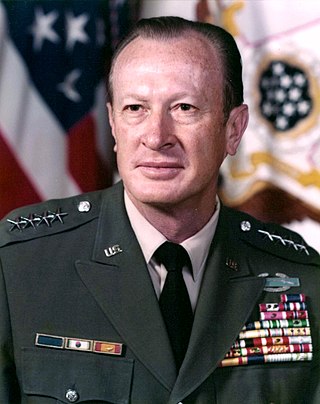
Frederick Carlton Weyand was a general in the United States Army. Weyand was the last commander of United States military operations in the Vietnam War from 1972 to 1973, and served as the 28th Chief of Staff of the United States Army from 1974 to 1976.

Charles Christopher "Hondo" Campbell was a United States Army officer who served as the 17th Commanding General, United States Army Forces Command (FORSCOM). He previously served as FORSCOM's Deputy Commanding General and Chief of Staff from April 26, 2006, to January 8, 2007. He assumed the commanding general assignment January 9, 2007, and completed it on June 3, 2010.

R. Steven Whitcomb is a retired United States Army lieutenant general. He was commissioned as a second lieutenant upon graduation from the University of Virginia in 1970. In his final assignment he served as Inspector General of the United States Army.

Robert Morin Shoemaker was a United States Army general and former commander of the United States Army Forces Command. He is also an inductee into the Aviation Hall of Fame.
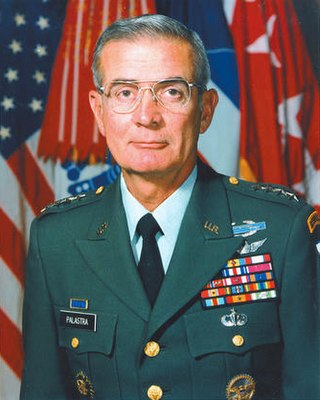
Joseph Thomas Palastra Jr. was a United States Army four-star general who served as Commanding General, United States Army Forces Command from 1986 to 1989. During his tenure, in 1987, the title was changed to Commander in Chief, Forces Command. He was inducted into the Ranger Hall of Fame, class of 2010.
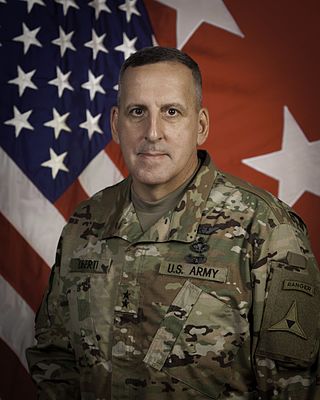
Major General John Uberti is a retired military officer who last served as the deputy commanding general for operations for the U.S. Army's III Armored Corps at Fort Hood, Texas.

Walter Francis Ulmer Jr. is a retired lieutenant general in the United States Army.

Lieutenant General Eugene Priest Forrester was a senior officer in the United States Army. He served as commander of United States Army Western Command from 1981 until his retirement in 1983.
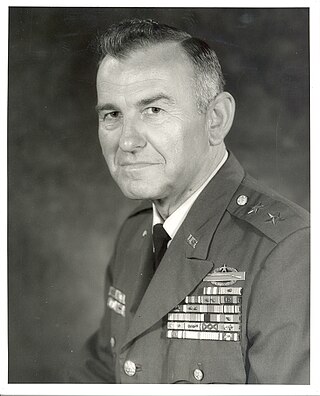
Robert Leahy Fair was a United States Army lieutenant general and a field commander in Germany during the Cold War. Fair commanded V Corps from August 25, 1975, until January 4, 1976. After 32 years in the U.S. Army and service in three wars, Fair concluded his career in 1976, and died in 1983.

The 525th Expeditionary Military Intelligence Brigade (Expeditionary) is a unit of the United States Army specializing in the acquisition and analysis of information with potential military value. On 28 October 2014, the unit was reflagged from the "525th Battlefield Surveillance Brigade" to an expeditionary military intelligence brigade, the first of its kind.

Patrick James Donahue II is a United States Army lieutenant general who served as deputy commander, United States Army Forces Command (FORSCOM).

Edward C. Peter II was a career officer in the United States Army. A veteran of the Korean War and Vietnam War, he attained the rank of lieutenant general and was most notable for his command of 2nd Battalion, 27th Infantry, the 1st Infantry Division Support Command, the Department of the Army Legislative Liaison Office, the 5th Infantry Division and Fort Polk, and Fourth United States Army. Peter received the Combat Infantryman Badge twice, and his awards and decorations included the Army Distinguished Service Medal (2), Silver Star (2), Legion of Merit (2), Bronze Star Medal (2), Meritorious Service Medal, Air Medal (6), and Army Commendation Medal.































